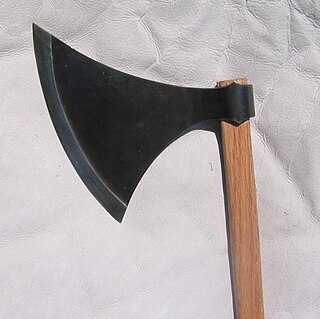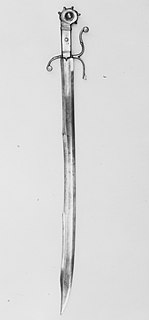 W
WA bearded axe, or Skeggøx refers to various axes, used as a tool and weapon, as early as the 6th century AD. It is most commonly associated with Viking Age Scandinavians. The hook or "beard", i. e. the lower portion of the axe bit extending the cutting edge below the width of the butt, provides a wide cutting surface while keeping the overall weight of the axe low.
 W
WA bill is a class of agricultural implement used for trimming tree limbs, which was often repurposed/modified for use as an infantry polearm. In English, the term 'Italian Bill' is applied to the similarly functioning ronche/runka/roncone. In contrast to the English bill, the Italian 'bill', tended toward long thrusting points. The English distinguished between several varieties of bill, including the black, brown and forest bills, but the differences between them are currently not fully understood. Bills were adapted to military use through addition of various projecting blades. Other variants include bill hook and bill-guisarme
 W
WThe Dane axe is an early type of battle axe, primarily used during the transition between the European Viking Age and early Middle Ages. Other names for the weapon include English long axe, Danish axe, and hafted axe.
 W
WA falchion is a one-handed, single-edged sword of European origin, whose design is reminiscent of the modern machete. Falchions are found in different forms from around the 13th century up to and including the 16th century. In some versions the falchion looks rather like the seax and later the sabre, and in other versions the form is irregular or like a machete with a crossguard.
 W
WThe francisca is a throwing axe used as a weapon during the Early Middle Ages by the Franks, among whom it was a characteristic national weapon at the time of the Merovingians from about 500 to 750 and is known to have been used during the reign of Charlemagne (768–814). Although generally associated with the Franks, it was also used by other Germanic peoples of the period, including the Anglo-Saxons; several examples have been found in England.
 W
WA glaive is a European polearm, consisting of a single-edged blade on the end of a pole. It is similar to the Japanese naginata, the Chinese guandao and pudao, the Korean woldo, the Russian sovnya, and the Siberian palma.
 W
WA halberd is a two-handed pole weapon that came to prominent use during the 14th, 15th, and 16th centuries. The word halberd is most likely equivalent to the German word Hellebarde, deriving from Middle High German halm (handle) and barte (battleaxe) joined to form helmbarte. Troops that used the weapon were called halberdiers.
 W
WThe khanda is a double-edge straight sword originating from the Indian subcontinent. It is often featured in religious iconography, theatre and art depicting the ancient history of India. It is a common weapon in Indian martial arts. Khanda often appears in Sikh, Jain, Buddhist and Hindu scriptures and art.
 W
WA messer is a single-edged sword with a knife-like hilt construction. While the various names are often used synonymously, messers are divided into two types:
 W
WA partisan is a type of polearm that was used in Europe in the 16th, 17th, and 18th century. It consisted of a spearhead mounted on a long shaft, usually wooden, with protrusions on the sides which aided in parrying sword thrusts. Like the halberd, it quickly became obsolete with the arrival of practical firearms, although it stayed in use for many years as a ceremonial weapon. In profile, the head of a partisan may look similar to that of a ranseur, spontoon, ox tongue, or spetum; however, unlike a ranseur, the lower parts of the head have a sharpened edge.
 W
WA rondel dagger or roundel dagger was a type of stiff-bladed dagger in Europe in the late Middle Ages, used by a variety of people from merchants to knights. It was worn at the waist and might be used as a utility tool, or worn into battle or in a jousting tournament as a side arm.
 W
WThe Swiss degen was a short sword (Degen), an elongated version of the Swiss dagger, with the same double-crescent shape of the guard. It was used as a type of side arm in the Old Swiss Confederacy and especially by Swiss mercenaries, from the first half of the 15th century until the mid 16th century. The native term used in the 15th century for this weapon was baselard. The term Schweizerdegen is first attested in 1499.
 W
WA voulge is a type of polearm that existed alongside the similar glaive in medieval Europe. Superficially, a voulge might strongly resemble a glaive, but there are some notable differences in construction. First, the attachment of the voulge blade to the shaft was usually done by binding the lower two thirds of the blade to the side of the pole; the glaive would often have a socket built into the blade itself and was mounted on top of the pole. In addition, while both had curved blades, that of the voulge was broad and meant for hacking, while that of the glaive was narrow and meant more for cutting. A voulge thus looks something like a squashed bardiche, or just a meat cleaver attached to a long pole. Troops that used the weapon are called voulgiers.